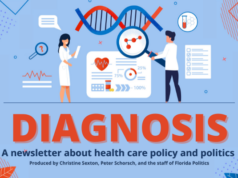
In 2021, US healthcare expenses made up 18.3% of the total GDP, and as the population grows, not only is the spending expected to increase, but the overall size of the market is also expected to grow.
According to estimates by Deloitte, healthcare spending in the US will triple by 2040, totaling close to $12 trillion. Additionally, the rapid advancements in technology have triggered substantial transformations in the sector. This factor, together with the after-effects of the COVID-19 pandemic, has given rise to some trends that are bound to shape the future of healthcare not just in the US, but the world over.
The trends that are currently being witnessed in the industry revolve around the use of Artificial Intelligence, nanotech, telemedicine, and remote monitoring devices. With groundbreaking advanced technologies and a focus on cost-effective health outcomes, analysts predict value-based care to become a norm as time progresses. These developments and changes in the market are driving sustainable shifts that will eventually determine the outlook of healthcare around the globe.
With these elements in mind, here are some of the trends that professionals associated with the field need to look out for:
Online healthcare education
Online education is not a new concept; people were acquiring new knowledge and education on the Internet before the pandemic. However, what was a luxury before 2020, has now not only become a practical need, but is also considered a more convenient way of acquiring higher education by professionals. From short courses to doctoral degrees, people can easily complete their educational credentials by pursuing online degrees while not having to give up other personal and professional commitments.
This is groundbreaking in the context of healthcare, as motivated individuals can now easily enroll in and complete unique subjects to become part of a growing and dynamic workforce. Students can complete an online MPH program (Masters in Public Health) and contribute valuable contributions to spreading awareness about community health concerns like infectious diseases and obesity. Or they can choose from a plethora of nursing bridge programs that make becoming a specialized nurse a lot easier. Online healthcare education will be the bridge that closes the gap between the shortfall of healthcare workers and the growing healthcare demands of the global population.
Virtual health services and telemedicine
A significant trend to watch is the rise of virtual healthcare and telemedicine services. Telehealth has grown in importance as a result of the COVID-19 pandemic and is anticipated to become so going forward, especially in North America, as the adoption of cutting-edge healthcare technologies is very high in the region. Currently, the telemedicine industry worldwide is worth more than $100 billion, which, by 2027, is expected to grow to $272 billion.
Spurred by the onset of digital worlds that was initiated by the COVID-19 pandemic, telemedicine and virtual health services have become the latest trends. Not only are these solutions decreasing the cost of healthcare overall, but they are also allowing the segment to become more easily accessible. Currently, more than 64% of the world’s population has access to the Internet, which means that they have the ability to avail virtual or telemedicine solutions that offer high-quality care hassle-free.
Rising incorporation of machine learning and AI
The growing application of machine learning (ML) and artificial intelligence (AI) in healthcare is another trend. AI and ML can be employed to analyze patient data, find patterns, and enhance clinical decision-making. Additionally, they can be utilized to tailor therapy regimens and enhance the results for individual patients. AI predictions are backed by solid data figures, which makes the analysis more accurate and suited to different cases.
The use of AI in healthcare has already begun, with one company recently developing an application to assist in the conduction of ultrasound scans. Artificial intelligence technology allows these scans to identify early signs of heart failure. This platform is now being acquired by GE Healthcare, one of the largest companies in the world. Moreover, AI is also enabling repetitive tasks to be automated while handling medical record management and the development of targeted treatments for rare ailments.
The growing trend of providing value-based care
Market analysts have called attention to an evolving trend of focus toward value-based healthcare. Healthcare professionals are compensated under value-based care that depends on patient outcomes instead of the number of services they render. This innovative approach could aid in reducing the unaffordable extent of medical expenses in nations like the United States. The value-based care (VBC) strategy, as it is commonly known these days, promises to provide patients with higher-quality care and outcomes at a lower cost.
The revenue risk and motivation for delivering higher value can be shared by a number of parties, including customers, providers of healthcare, and medical technology (Medtech) firms. Western European nations are next in the adoption of VBC, after the United States. The affordability of high-quality medical care has always been a concern for low-income families, but with the growing trends of focusing on VBC, the outlook of the industry is changing for the better. Doctors and other healthcare staff can continue to be paid for their services while, at the same time, lowering costs for the patients.
Focus on cybersecurity in healthcare
The pressing requirement for healthcare cybersecurity is the final trend. Healthcare providers are experiencing significant security issues as more patient data is being electronically stored and sent. Cyberattacks have the potential to compromise patient data, interfere with medical procedures, and harm a provider’s reputation. The number of healthcare hacking incidents recorded in North America increased by 42% alone in 2020 as cybercriminals tried to take advantage of a weak point in already overburdened health systems.
Healthcare organizations are investing in cybersecurity solutions to stop these dreadful security breaches, which will accelerate the growth of the healthcare cybersecurity industry. With their data secure, not only will patients gather more confidence in medical facilities, but at the same time, hospitals and other installations will be able to avoid monumental losses that come from digital breaches on their systems.
The healthcare market, like many other industries, is experiencing a substantial shift thanks to technology-based solutions. However, the thing with the trends that technology is influencing is that they can shift drastically and rapidly.
At present, the prevalent trends include the use of AI, machine learning, telemedicine, the focus on value-based care, online healthcare education, and, finally, cybersecurity investments. These are trends that are expected to continue for some years in the future, at least.












